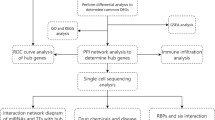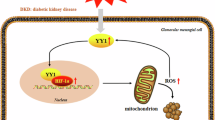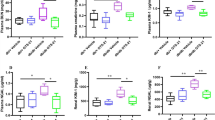Abstract
Diabetic nephropathy is characterized by an expansion of glomerular mesangium, caused by mesangial cell proliferation and excessive accumulation of extracellular matrix (ECM) proteins, which eventually leads to glomerulosclerosis and renal failure. Activator protein-1 (AP-1), a transcription factor, is implicated in the transcriptional regulation of a wide range of genes participating in cell proliferation and ECM production. This investigation was undertaken to test the hypothesis that AP-1 plays an important role in ECM gene expression, and to develop a molecular therapeutic strategy based on decoy oligodeoxynucleotides (ODN). In this report, we show that transfection with AP-1 decoy ODN strongly inhibits high glucose- and angiotensin II-induced cell proliferation and expression of ECM genes in cultured mesangial cells in vitro. Administration of AP-1 decoy ODN into streptozotocin-induced diabetic rat kidney in vivo using the hemagglutinating virus of Japan (HVJ)-liposome method virtually abolished TGF-β1 and plasminogen activator inhibitor-1 expression. Our results collectively indicate that AP-1 activation is crucial for mesangial cell proliferation and ECM production in response to high glucose and angiotensin II. Moreover, use of stable AP-1 decoy ODN combined with the highly effective HVJ-liposome method provides a novel potential molecular therapeutic strategy for the prevention of diabetic nephropathy.
This is a preview of subscription content, access via your institution
Access options
Subscribe to this journal
Receive 6 print issues and online access
$259.00 per year
only $43.17 per issue
Buy this article
- Purchase on SpringerLink
- Instant access to full article PDF
Prices may be subject to local taxes which are calculated during checkout







Similar content being viewed by others
References
Steffes MW, Osterby R, Chavers B, Mauer SM . Mesangial expansion as a central mechanism for loss of kidney function in diabetic patients. Diabetes 1989; 38: 1077–1081.
Klahr S, Scheiner G, Ichikawa I . The progression of renal disease. N Engl J Med 1988; 318: 1657–1666.
Leehey DJ, Singh AK, Alavi N, Singh R . Role of angiotensin II in diabetic nephropathy. Kidney Int 2000; 58: S93–S98.
Wolf G et al. High glucose-induced proliferation in mesangial cells is reversed by autocrine TGF-β. Kidney Int 1992; 42: 647–656.
Wolf G, Haberstroh U, Neilson EG . Angiotensin II stimulates the proliferation and biosynthesis of type I collagen in cultured murine mesangial cells. Am J Pathol 1992; 140: 95–107.
Hamaguchi A et al. Activation of glomerular mitogen-activated protein kinases in angiotensin II-induced hypertension. J Am Soc Nephrol 1998; 9: 372–380.
Hamaguchi A, Kim S, Izumi Y, Iwao H . Chronic activation of glomerular mitogen-activated protein kinases in Dahl salt-sensitive rats. J Am Soc Nephrol 2000; 11: 39–46.
Karin M . The regulation of AP-1 activity by mitogen-activated protein kinases. J Biol Chem 1995; 270: 16483–16486.
Whitmarch AJ, Davis RJ . Transcription factor AP-1 regulation by mitogen-activated protein kinase signal transduction pathway. J Mol Med 1996; 74: 589–607.
Leppa S, Bohmann D . Diverse functions of JNK signaling and c-Jun in stress response and apoptosis. Oncogene 1999; 18: 6158–6162.
Sharma K, Jin Y, Guo J, Ziyadeh FN . Neutralization of TGF-β by anti-TGF-β antibody attenuates kidney hypertrophy and the enhanced extracellular matrix gene expression in STZ-induced diabetic mice. Diabetes 1996; 45: 522–530.
Sharma K, Ziyadeh FN . Hyperglycemia and diabetic kidney disease: the case for transforming growth factor-β as a key mediator. Diabetes 1995; 44: 1139–1146.
Bielinska A, Shivdasani RA, Zhang L, Nabel GJ . Regulation of gene expression with double-stranded phosphorothioate oligonucleotides. Science 1990; 250: 997–1000.
Morishita R et al. In vivo transfection of cis element ‘decoy’ against NF-kB binding site prevented myocardial infarction as gene therapy. Nat Med 1997; 3: 894–899.
Ahn JD et al. Transcription factor decoy for activator protein-1 (AP-1) inhibits high glucose- and angiotensin II-induced type 1 plasminogen activator inhibitor (PAI-1) gene expression in cultured human vascular smooth muscle cells. Diabetologia 2001; 44: 713–720.
Ahn JD et al. Inhibitory effects of novel AP-1 decoy oligodeoxynucleotides on vascular smooth muscle cell proliferation in vitro and neointimal formation in vivo. Circ Res 2002; 90: 1325–1332.
Tomita N et al. Transcription factor decoy for NF-kappaB inhibits TNF-alpha-induced cytokine and adhesion molecule expression in vivo. Gene Therapy 2000; 7: 1326–1332.
Vos IH et al. NF-kappaB decoy oligodeoxynucleotides reduce monocyte infiltration in renal allografts. FASEB J 2000; 14: 815–822.
Tomita N et al. An oligonucleotide decoy for transcription factor E2F inhibits mesangial cell proliferation in vitro. Am J Physiol 1998; 275: F278–F284.
Maeshima Y et al. Inhibition of mesangial cell proliferation by E2F decoy oligodeoxynucleotide in vitro and in vivo. J Clin Invest 1998; 101: 2589–2597.
Han DC et al. Therapy with antisense TGF-β1 oligodeoxynucleotides reduces kidney weight and matrix mRNAs in diabetic mice. Am J Physiol Renal Physiol 2000; 278: F628–F634.
Grandaliano G et al. Tissue factor, plasminogen activator inhibitor-1, and thrombin receptor expression in human crescentic glomerulonephritis. Am J Kidney Dis 2000; 35: 726–738.
Nakamura T et al. The localization of plasminogen activator inhibitor-1 in glomerular subepithelial deposits in membranous nephropathy. J Am Soc Nephrol 1996; 7: 2434–2444.
Morishita R et al. Role of AP-1 complex in angiotensin II-mediated transforming growth factor-β expression and growth of smooth muscle cells: using decoy approach against AP-1 binding site. Biochem Biophys Res Commun 1998; 243: 361–367.
Ahn JD et al. Novel E2F decoy oligodeoxynucleotides inhibit in vitro vascular smooth muscle cell proliferation and in vivo neointimal hyperplasia. Gene Therapy 2002; 9: 1682–1692.
Acknowledgements
This work was supported by grants from the Korean Science and Engineering Foundation (R01-2001-000-00114-0).
Author information
Authors and Affiliations
Rights and permissions
About this article
Cite this article
Ahn, J., Morishita, R., Kaneda, Y. et al. Transcription factor decoy for AP-1 reduces mesangial cell proliferation and extracellular matrix production in vitro and in vivo. Gene Ther 11, 916–923 (2004). https://doi.org/10.1038/sj.gt.3302236
Received:
Accepted:
Published:
Issue date:
DOI: https://doi.org/10.1038/sj.gt.3302236
Keywords
This article is cited by
-
Network pharmacology and molecular docking technology-based predictive study of the active ingredients and potential targets of rhubarb for the treatment of diabetic nephropathy
BMC Complementary Medicine and Therapies (2022)
-
Urotensin II-induced store-operated Ca2+ entry contributes to glomerular mesangial cell proliferation and extracellular matrix protein production under high glucose conditions
Scientific Reports (2017)
-
Ascochlorin suppresses TGF-β1-induced PAI-1 expression through the inhibition of phospho-EGFR in rat kidney fibroblast cells
Molecular Biology Reports (2012)
-
Urocortin ameliorates diabetic nephropathy in obese db/db mice
British Journal of Pharmacology (2008)
-
Aberrant Expression of Fra-1 in Estrogen Receptor-negative Breast Cancers and Suppression of their Propagation In Vivo by Ascochlorin, an Antibiotic that Inhibits Cellular Activator Protein-1 Activity
The Journal of Antibiotics (2007)



